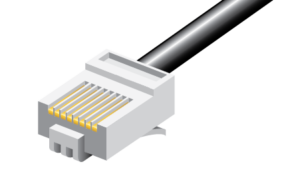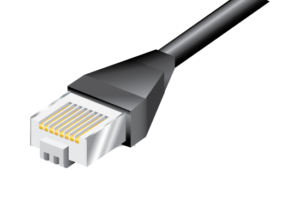Network Media – Cable
The network media is part of the physical layer of a LAN network as defined by the OSI Open Systems Protocol Reference Model, see Table 1. It is the medium through which the information is passed from one device in the network to another. Although wireless methods of relaying information are becoming more and more prevalent, typically networks are connected using cables.
Table 1 – OSI Reference Model
| OSI Layer | Name | Common Protocols | |
|---|---|---|---|
|
7 |
Application |
HTTP FTP SMTP DNS |
|
|
6 |
Presentation |
||
|
5 |
Session |
||
|
4 |
Transport |
TCP |
SPX |
|
3 |
Network |
IP |
IPX |
|
2 |
Data Link |
Ethernet |
|
| 1 | Physical | ||
Multiple types of cables exist, and LANs can use a single type of cable or a variety. The cable used is determined by the network’s topology, protocol and size. Knowledge of the characteristics of the different cables and how they relate to the network provides an essential part of developing a sound network.
Twisted Pair Cable
Twisted pair cable is used in most telephone communications and in most Ethernet networks. There are two types of twisted pair cable, shielded and unshielded.
Unshielded Twisted Pair (UTP)
UTP cable has eight individual copper wires each covered by an insulating media. The wires are then twisted in pairs. The wires are twisted to eliminate “noise” generated by adjacent pairs and other electronics. The number of twists in each wire pair is varied to further eliminate noise. See Figure 1.
Figure 1 – Unshielded Twisted Pair

Varied number of twists in the wire pairs eliminates electronic interference from other wire pairs.
UTP cable follows precise specifications governing the number of twists permitted per meter of cable. The Electronic Industry Association/Telecommunications Industry Association (EIA/TIA) has established ratings of UTP cable shown in Table 2.
Table 2 – Categories of Unshielded Twisted Pair
| Category | Speed | Use |
|---|---|---|
| 1 | 1 Mbps | Voice Only (telephone wire) |
| 2 |
4 Mbps |
LocalTalk & Telephone |
| 3 |
16 Mbps |
10BaseT Ethernet |
| 4 |
20 Mbps |
Token Ring |
| 5 |
100 Mbps (2 pair) |
100 BaseT Ethernet |
|
1,000 Mbps (4 pair) |
Gigabit Ethernet |
|
| 5e |
1,000 Mbps |
Gigabit Ethernet |
| 6 |
10,000 Mbps |
Gigabit Ethernet |
When used for networking, UTP has four pair of 22 or 24-gauge copper wire, and has an impedance of 100 ohms. Twisted pair for other uses, such as telephone wiring has an impedance of 600 ohms. The standard connector for UTP is the RJ-45 connector. The RJ-45 is plastic and looks like a large telephone-style connector. In fact, RJ stands for Registered Jack which alludes to its origin in the telephone industry, see Figure 2.
Figure 2 – RJ-45 Connector

Among the advantages of UTP cable for networking are the relatively small diameter, its ease of installation, flexibility with a variety of network architectures, and minimal cost. The disadvantages are its susceptibility to electrical noise compared to other networking media, and the shorter distance between signal boosts.
Shielded Twisted Pair (STP)
The susceptibility of UTP to electrical noise has made STP cable popular in environments where there is a lot of potential interference. Like the UTP cable the wires are twisted into four pairs with varying number of twists. Then each pair is individually shielded with foil. The four pairs of wires are then wrapped in a group with metallic braid or foil. See Figure 3. STP cable is generally installed with an STP data connector, however it can be installed like UTP using an RJ-45 connector.
While STP is better at preventing interference than UTP, the costs are higher and it is more difficult to install. Additionally, the metallic shielding must be grounded properly on both ends, or it will act like an antenna and pick up unwanted signals. STP is rarely used in Ethernet networks.
Figure 3 – Shielded Twisted Pair

Metallic shielding prevents interference better, however it requires grounding on both ends to be effective.
Coaxial Cable
Coaxial cable has a single copper conductor in the center, surrounded by a layer of flexible insulation, which is then covered by a layer of woven copper braid or metallic foil. The foil layer provides shielding from interference, as well as acting as the second wire in the circuit. Covering the coaxial construction is a cable jacket. Although coaxial cost more than UTP, it is still relatively inexpensive, and allows the cable to be run over longer distances, this means it requires fewer boosts from repeaters. Disadvantages of coaxial include the thickness, which can reach 1 centimeter in diameter. Generally, as cable thickness increases, so does the difficulty in working with it, and the expense to install it. Another issue associated with coaxial is improper grounding during installation, resulting in electrical noise and signal interference. There are two types of coaxial thicknet and thinnet.
Thicknet
As the name implies thicknet has the larger diameter of the two. It features an extra protective plastic cover that helps keep moisture away from the center conductor. With its diameter reaching 1 cm, thicknet can be too rigid to install in some situations, and is generally used for special purpose installations or as the backbone in a linear bus network.
Thinnet
Thinnet, has an outside diameter of only .35 cm and was used in Ethernet networks. Its thinner diameter allowed it to be used where twists and turns were necessary. Despite its flexibility, the issues arising from improper grounding of coaxial cable have basically eliminated thinnet from use in Ethernet networks.
Fiber Optic Cable
Fiber optic cable is built around a center core made of glass or plastic fibers. A plastic coating cushions the fiber center and Kevlar fibers help strengthen the cables. Then an outer, insulating layer of Teflon or PVC is used. Fiber optic cable eliminates problems with interference because it transmits light rather than electrical signals. Fiber optic is able to transmit over longer distances than either twisted pair or coaxial and is capable of greater speeds. The cost to install, and the connectors for coaxial are more expensive than twisted pair and coaxial.
Ethernet Cable Summary
| Specification | Cable Type |
|
10BaseT |
Unshielded Twisted Pair |
|
10Base2 |
Thin Coaxial |
|
10Base5 Thick Coaxial |
Thick Coaxial |
|
100BaseT |
Unshielded Twisted Pair |
|
100BaseFX, BX, SX |
Fiber Optic |
|
1000BaseT Unshielded Twisted Pair |
Unshielded Twisted Pair |
|
1000BaseFX, BX, SX |
Fiber Optic |
Cable is the medium through which information moves from one device to the other. The type of cable chosen for a network is related to its topology. Understanding the characteristics of different cable types is necessary for the development of a successful network.
